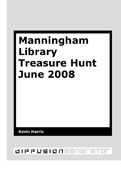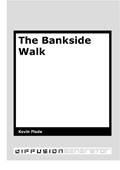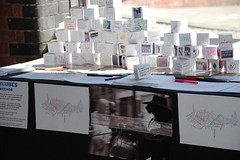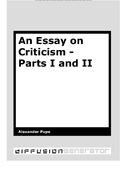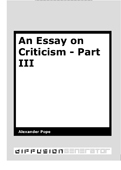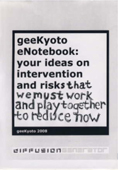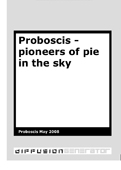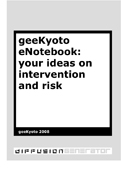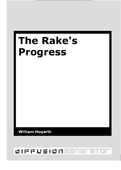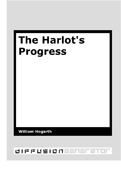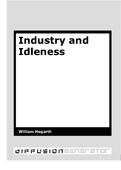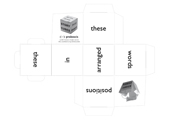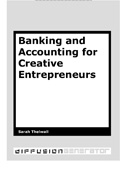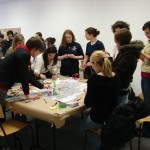Articles by Giles Lane
Giles Lane is founder and co-director of Proboscis. He conceived of and developed the Diffusion eBook format with Paul Farrington and designed the Proboscis StoryCube.

Download A4 only PDF 5.6Mb
Proboscis is proud to announce our first ‘StoryBox’ of digitally printed and die-cut StoryCubes: an 8 cube set printed on both sides which enables people to explore Proboscis, our projects, themes and ideas in three dimensions.
We have a limited number available to buy from our webstore.
This is the first of a number of StoryBoxes which we will be publishing in the next year. Future ones include creative works by sound artist, Loren Chasse; a special set on our Snout project; a 27 cube set about Social Tapestries and a new edition of the Gordon Pask cubes, first shown last year in the Maverick Machines exhibition, Edinburgh.
Custom Printed StoryCubes
Proboscis is now offering a service to design and manufacture custom printed StoryCubes – e.g. for marketing campaigns or communication projects – for single or double-sided cubes with as many different StoryCube designs as you like.
Please contact us for pricing at sales(at)proboscis.org.uk

A set of 7 StoryCubes created for Survey Sampling International Ltd as marketing tools for their offices in the UK, France, Spain, Holland, Germany and Scandinavia.

I’ve been working recently with Bradford Libraries (West Yorkshire, England) on a few small community engagement projects. They have received funding under the Community Libraries Programme to extend and refurbish the library at Manningham. In June 2008 I was asked to run a public event in the library to engage people with the process and open up a period of consultation.
The intention was to have a two hour early evening slot, with the architect and plans available, plus members of staff of course, but no set programme. So the first condition was to design a consultation event where people are constantly coming and going, but you want to attract their attention, inform them, provoke thinking and capture their views.
The idea of a treasure hunt as a fun way to generate interest quickly became the key component of the event. Working with library staff I developed a set of clues which would require users to go to specific locations in and around the building. The planned extension will be built over part of an existing car park and a community garden will be designed alongside, so we had the chance with the treasure hunt to help people visualise it. I was pretty sure that the Diffusion eBooks would be the ideal mechanism for linking clues to further suggestions and comments.

Here’s how it worked. Visitors were given an eBook, with the first clue printed on the first page. Each clue required the hunter to go to a specific location, inside or outside the library building, where they would find the next clue printed on a set of peel-off labels. They took one of these labels and stuck it onto a space on a new page in the eBook.

We provided space on each page for hunters to write an answer to each clue. Additionally there was a supplementary consultative question, designed to solicit ideas and suggestions for the new building.
So for example, the second clue asked “Where will the disabled parking spaces be?” This required checking the site plans, with the architect on hand to help work out the answer. The hunter then had to pop outside to the specific location, where friendly staff held a folder of labels for clue 3. If necessary, users were shown where the label should be placed in their eBook. The supplementary question asked: “What else is needed to make sure that disabled people have good access to the new library?”

At the location of the answer to the final clue, users found a note saying “Well done! You’ve finished the treasure hunt – please go back to the start and collect your prize.”
We anticipated that some users would rather get on with the hunt, and then perhaps settle down afterwards to write comments in answer to the questions. In practice, we found that most took this course and staff were on hand to encourage and support comment. Nonetheless, it was obvious that a number of hunters lacked confidence writing in the English language and were reluctant to offer any comments. Aware of this, staff engaged most of them in conversation and anyway it didn’t matter – they were in the library, taking part, willingly engaged and ready to contribute in other ways.
What worked well
The treasure hunt clues and the eBooks were developed remotely, with staff locally printing out the eBooks and, never having encountered them before, making them up a day or two in advance. As always, one or two showed greater dexterity than others, but it was done. I travelled to Bradford on the day of the event knowing that the documentation was ready.
In terms of helping to guide people through the treasure hunt process, the eBooks worked flawlessly. No-one got lost or did the clues in the wrong order. And no-one got into any difficulty with the sticking of labels: every one was placed in the right place on the right page.
We printed some eBooks on A3, giving a page format of around 21 x 15cm. These proved more popular and suited being carried around for 15-30 minutes, allowing plenty of space for notes.
What I’d do differently
We had the smaller eBooks printed on yellow paper, but ideally I’d like to introduce some colour in other ways and the obvious place to do this is with the sticky labels.

A key point
It’s important not to see this as an engagement technique in a vacuum. If we did, we wouldn’t get results. We ran this exercise while the library was open, with staff having conversations with users, an SMS option for comments, and other opportunities for people to get involved in the decision-making process. The eBooks fit perfectly in the treasure hunt and the treasure hunt is just one component in an ongoing mix of engagement activities and processes.
Kevin Harris
June 2008
Read Kevin’s post on his Neighbourhoods blog.

Download A4 | US Letter PDF 262Kb
About : an eNotebook created for a Treasure Hunt at Manningham Library, Bristol.
Published June 2008
Kevin Harris is a community development consultant and writer (Local Level). He blogs on neighbourhoods, neighbourliness, social capital and life at local level.

Download A4 | US Letter PDF 280Kb
About : A guided walk through Historic Southwark.
Published June 2008
Kevin Flude’s main interests are the history, archaeology and museums of London. He has been proprietor of And Did Those Feet (Cultural Heritage Resources) since 1982. It has allowed him the opportunity of working in a variety of fields in the Heritage world. He is currently Director of the Old Operating Theatre Museum in Southwark; Associate Lecturer at the Central Saint Martins College of Art and Design, University of the Arts, London and Worcester University and Course Director for the Elderhostel programme in London which provides study tours, lectures and walks on the history, archaeology architecture and art of London. Visit his blog here.

Download A4 | US Letter PDF Kb
About : Karen is currently the Director and Curator of Interval. and a Researcher at the Foundation for Art and Creative Technology (FACT) in Liverpool. She is also currently completing her practice-based PhD in Digital Media and Social Practice at the Digital Research Unit, The University of Huddersfield. The interview with Karen covered topics ranging from getting outside of the white cube to the expanding role of the audience. This interview, the second in the series of eBooks that will be released on www.curating.info, is intended to become part of a larger conversation. Comments on the topics raised in this series of eBooks are welcomed, and responses may be collected later into a companion eBook.
Published June 2008
Michelle Kasprzak is a curator, writer, and artist. Since winning the InterAccess Electronic Media Arts Centre Emerging Electronic Artist award early in her career, she has exhibited her work throughout North America and Europe, and has been featured in numerous publications and on radio and television broadcasts syndicated worldwide. She completed her MA in Visual and Media Arts from the Université du Québec à Montréal in spring of 2006, and later that year was awarded a curatorial research residency at the Nordic Institute for Contemporary Art (NIFCA) in Finland. She has published essays on art in CV Photo, Spacing, and Mute, and her most recent curatorial project was Otherworldly, a video programme that is currently touring urban screens around the globe. Michelle is currently based in Edinburgh.
michelle.kasprzak.ca, www.curating.info
Download
Manchester Beacon Workshop eBook A4 | US Letter PDF 1.8Mb
Manchester Beacon Workshop StoryCubes A4 only PDF 1.9Mb
b.TWEEN StoryCubes A4 only PDF 3.8Mb
About : The eBook is a document of the ideas, issues and challenges for an “an online service that maps connections between people, places, knowledge and creative activity in Manchester” – an new tool for public engagement and knowledge transfer for Manchester to be commissioned by the Manchester Beacon Project and Just b. Productions. It records the activities of workshop facilitated by Proboscis in Manchester in June 2008; 16 StoryCubes created during the workshop are also available, as well as 24 of the StoryCubes created by delegates and the public at b.TWEEN08 as part of the ‘landscape of ideas’ for the commission brief.
The workshop and StoryCubes installation was facilitated and documented by Proboscis for Just b. Productions by Giles Lane and Karen Martin.

As part of b.TWEEN08 in Manchester, Proboscis is facilitating a StoryCubes ‘landscape of ideas’ to help Just b. Productions and the Manchester Beacon Project define the brief for a new commission to create an online public engagement service that maps connections between people, places, knowledge and creative activity in Manchester. Starting with an initial day-long workshop to scope out the wider issues, aspirations and challenges for the design brief, a series of questions are being posed to the delegates of b.TWEEN to add their comments ideas and suggestions to:
– Who are the key people and networks that engagement tools should target?
– What makes engagement tools sustainable?
– What themes would inspire people to connect using engagement tools?
– What opportunities should engagement tools offer their participants?
– What shouldn’t engagement tools be or do?
– What are reasonable and achievable expectations for engagement tools?
– What local communities should benefit most from engagement tools?
– What kinds of links to the physical world should engagement tools have?
The word cloud (created using Wordle) above was generated from StoryCubes created during the workshop (June 17th) and on the first day of b.TWEEN08 (June 19th). The StoryCubes will be scanned in and shared online as inspirations for creative teams wishing to pitch concept proposals for the commission…
Update: the word cloud after day two
Update 2 : We are really excited to be able to say that the delegates of b.TWEEN voted StoryCubes the Best Interactive Gallery Installation.

Download A4 only PDF 1.1Mb
About : 24 StoryCubes making up a ‘landscape of ideas’ created by participants at geeKyoto2008.

Download
Parts I and II A4 | US Letter PDF 450Kb
Part III A4 | US Letter PDF 280Kb
Selected and Introduced for Short Work by Sebastian Mary Harrington, associate at the Institute for the Future of the Book.
Alexander Pope’s Essay on Criticism (1711), written when he was only 20, laid the foundations for many of the artistic and critical hierarchies that have remained constant since in the literary world.
The late seventeenth and early eighteenth centuries in London saw the growing mechanisation of print publishing, and a concurrent boom in both literary production and criticism. Equally, new sales and distribution models increasingly enabled writers to make a living independent of the aristocratic patronage that had been their commonest means of support in earlier times.
The glut of writing, and divorce of that writing from the values and aesthetics associated with the ruling classes, prompted a vigorous tussle for critical supremacy among those who believed themselves qualified to pronounce on literature. A widely influential – and hotly contested – intervention in this tussle, Pope’s Essay on Criticism seeks to antedate his creative activities in the Greek and Roman past, by replacing the overt eulogising of aristocratic values with an insistence on the primacy of the classical canon. Pope aims to draw from this composite ancient and modern canon a set of precepts from which his contemporary literature and criticism can be judged.
The age of the blogosphere has seen an equivalent explosion in writing, criticism and debate. While few now read Homer, Pope’s essay addresses questions of authority, quality and cultural legitimacy that, online, are as vigorously contested as ever.
Sebastian Mary Harrington
June 2008
Alexander Pope (1688-1744) is one of the most acclaimed English poets of the early eighteenth century. Amongst his well known works are The Rape of the Lock, The Dunciad, Essay on Man and his translations of Homer’s The Iliad and The Odyssey.
First Published in London 1711
Sourced from Project Gutenberg

Download
eNotebook 1 by Graham A4 only PDF 145 Kb
eNotebook 2 by Michael Evans A4 only PDF 176 Kb
eNotebook 3 by Agnieska Gryglewicz A4 only PDF 163 Kb
eNotebook 4 by Laura A4 only PDF 136 Kb
eNotebook 5 by Lucy K Wills A4 only PDF 180 Kb
eNotebook 6 by Alex Haw A4 only PDF 197 Kb
About : Six eNotebooks completed by participants at geeKyoto2008 (Saturday May 17th 2008, Conway Hall London).

Download US Letter only PDF 2.75Mb
About : Sublimation is the result of a collaboration between three artists. Tim Graveson is a photographer, Joyce Majiski is a printmaker and multi-media artist, and I make books and paint onto mass-produced books. Tim Graveson, who is my husband, and I and Joyce Majiski went on a rafting trip down the Alsek River in the Yukon Territory of Canada. Joyce was one of the guides on this trip and she had persuaded us to go because of the sheer beauty of the place. The trip culminates at Lowell Lake at the foot of Lowell Glacier — where we camped for a couple of days. When we got back we stayed with Joyce and came up with some ideas for a collaborative exhibition of work based on this trip. And Joyce and I started to make some books together. I also wanted to make some books that would incorporate all of our work. Sublimation turned out to be one book where I could bring all of the strands together. Using a book found by Joyce, I made some pages based on the subject of Sublimation. Until Joyce explained it to me, I thought sublimation only referred to a psychological state, I did not know it had a chemical and an alchemical meaning. While staying with Joyce, I came across one of her eBooks and immediately wanted to design one of my own. After I’d begun the unique altered book on Sublimation, I decided it would be just right for an eBook. In the course of making it I came up with some ideas about page layout using the standard vertical eBook format.
Published May 2008

Download US Letter only PDF 470Kb
About : The first eBook that I made is titled “Notebook Drawing” and I made it just using drawings that I had on hand. I always carry a notebook and pencil with me and afterwards I use the drawings in other art projects and in other books that I make. I didn’t have a subject in mind at that moment, so I used my somewhat obsessive notebook-making as the subject, and created some text for my first Diffusion eBook. I was not happy with the vertical page flip design of the original ebook and re-thought it in a horizontal format which suited my concept better. When I print this book out for myself, I use an ivory or buff colored paper to simulate the color of the original notebook pages. I felt a little shy about submitting this book because it seems a bit narcisisistic in comparison to the socially engaged work that I see on the Proboscis website.
Published May 2008
Zea Morvitz is an artist living near San Francisco in Northern California. She received an MA in painting from the University of California in Berkeley and has since exhibited work in the U.S. and in Europe. Her current work involves drawing and painting on mass-produced books that were discarded and on their way to landfill. In this work four to sixteen books are arranged on the wall in a grid configuration. She also makes and binds books, working primarily in graphite and mixed media. Trained as a book designer, she continues to be interested in graphic design. She and her husband, photographer Tim Graveson are working on an collaborative project titled “Worked Books” that will be installed at the Market Place Center in Armagh, Northern Ireland in August, 2008. Besides being an artist, Morvitz works as a curator and administrator for Gallery Route One, a small nonprofit, community based art organization in Point Reyes Station.

Download A4 | US Letter PDF 280Kb
About : This eNotebook has been created for geeKyoto2008. Proboscis and the organisers have collaborated to design this notebook for delegates (and others who can’t make it to the event) to share their thoughts and ideas, observations and hopes, fears and aspirations for the future of the planet. The completed eBooks will be collected up, scanned and made into an online library of ideas to inform and help shape future geeKyoto events. If you can’t attend but would like to share your ideas download and make up the eBook, fill it in and post it to Proboscis at 1st Floor, 24 Rosebery Avenue, London EC1R 4SX, UK. We will scan it in and add it to those completed during the event.
geeKyoto2008
Fixing The Broken World
10:00 – 16:30 – Saturday 17th May 2008. Conway Hall, London. £20.
We broke the world. Now what?
A one day conference in central London organised by Mark Simpkins and Ben Hammersley, with designers, technologists, artists, architects, policy-makers, explorers, economists and scientists, and clever people like you, to discuss the future and how we’ll live in it.

Download
Of the Origin and Design of Government in General A4 | US Letter PDF 300Kb
Of Monarchy and Hereditary Succession A4 | US Letter PDF 350Kb
Thoughts on the Present State of American Affairs (Part 1) A4 | US Letter PDF 340Kb
Thoughts on the Present State of American Affairs (Part 2) A4 | US Letter PDF 330Kb
Of the Present Ability of America A4 | US Letter PDF 520Kb
Appendix A4 | US Letter PDF 450Kb
Selected and Introduced for Short Work by Alex Steffen, editor of Worldchanging
Bombarded as we are with advertising and propaganda looking to link products or candidates to the concept of freedom, we tend to lose sight of how radical a set of ideas democracy, personal liberty and human rights really are, and how recently, really, the fight to make them the universal rule began. The best antidote to that forgetfulness is Common Sense, the book that, in a very real sense, can be credited with raising the American public will to revolution. It was a radical and deep document then. It is still radical today. Would that we had more writers with Paine’s passion, skill and clarity today.
Alex Steffen
April 2008
Thomas Paine (1737-1809). Englishman by birth. American by choice. French by decree. Citizen of the World.
First Published in Philadelphia 1776
Sourced from Project Gutenberg

Download A4 | US Letter PDF 1.6Mb
About : The Rake’s Progress follows Tom Rakewell as wealthy merchant’s son in his downward spiral from young man of fashion to gambler, drunk, debtor and lunatic.
William Hogarth (1697-1764) was one of England’s foremost artists working as a painter, printmaker and engraver. His work is probably best known for its social commentary and satiric look on British social and cultural mores on the mid 1700s.
First Published June 1735
Public Domain version sourced from Project Gutenberg

Download A4 | US Letter PDF 1.2Mb
About : The Harlot’s Progress describes the path of Moll Hackabout from country innocent newly arrived in London to prostitute, prison inmate, mother and finally victim of venereal disease.
William Hogarth (1697-1764) was one of England’s foremost artists working as a painter, printmaker and engraver. His work is probably best known for its social commentary and satiric look on British social and cultural mores on the mid 1700s.
First Published April 1732
Public Domain version sourced from Project Gutenberg

Download A4 | US Letter PDF 2Mb
About : Industry and Idleness contrasts two apprentices, one who’s hard work leads him to a life of wealth and power; the other whose idleness drives him to criminality and execution.
William Hogarth (1697-1764) was one of England’s foremost artists working as a painter, printmaker and engraver. His work is probably best known for its social commentary and satiric look on British social and cultural mores on the mid 1700s.
First Published June 1735
Public Domain version sourced from Project Gutenberg

MyCake provides an online book-keeping and benchmarking service specially designed to meet the needs of Creative Entrepreneurs. MyCake is a subscription based service whereby you receive 2 months free to test the service and see if it suits you and then subscribe at a cost of £10/month + VAT.
In addition to the online services MyCake is producing a series of eBooks explaining key ideas and concepts in financial management which are intended to help Creative Entrepreneurs understand how to manage their money more effectively. The eBooks have been created in response to a needs analysis provided by MyCake’s users. Anyone can contribute to the needs analysis by completing this survey.
The series includes:
- Planning for Success in 2008 (March 2008)
- Banking & Accounting for Creative Entrepreneurs (April 2008)
- Managing your cashflow (part 1)
- Managing your cashflow (part 2)
- How to price your time and your products
- Planning for profitability
- Budgetting for the year ahead
- What’s a Cashflow Forecast?
- Becoming more profitable
- How can I grow & develop my business?
- Business Models: what are they and how to I get one?
- Managing stock using MyCake
Sarah Thelwall
April 2008

Download
cube (after Ludwig Wittgenstein) PDF 1.5Mb
cube (score/fold) PDF 1.5Mb
About : This pair of cube poems can be viewed – or made – in the context of Finlay’s other poetic forms: the mesostic name poem; circle poems and the related windmill turbine text designs and wordrawings; and the grid poem and sliding puzzle poem objects derived from these. The text ‘your finger / my thumb’ was originally used in a performance collaboration with Dan Civico, for which Finlay made a handwritten circular wordrawing from these two phrases, while Civico folded origami cubes. Together with Guy Moreton and Michael Nedo, Finlay published Ludwig Wittgenstein: There Where You Are Not (Black Dog, 2005), a consideration of the Wittgenstein house at Skjolden in Norway.
Published April 2008
Alec Finlay (1966, Scotland) – Artist, poet and publisher, lives and works in Byker, Newcastle-upon-Tyne
Finlay has produced a series of card cut-out nest-box schema, in collaboration with Jo Salter (available free from www.alecfinlay.com). His most recent publications are two fields of wheat seeded with a poppy-poem (Milton Keynes Gallery); Specimen Colony (Liverpool University Press) and One Hundred Year Star-Diary (platform projects). He is is currently showing in herz:rasen at Kunstlerhaus Vienna (until July 6), where he is exhibiting Labanotation: the Archie Gemmil goal (2002), a collaboration with Robin Gillanders; and now then at the Bluecoat (Liverpool). His next exhibition, thoughts within thoughts, a duet with Pravdoliub Ivanov will open at Arc projects (Sofia) in late June 2008.

Download A4 | US Letter PDF 300Kb
About : The first in a series of eBooks by MyCake created in response to the needs identified in the JSIP/MyCake ‘My Money Matters’ programme and the Creative Northants/MyCake 1:1 programme. This eBook covers:
- When & why do I need a business bank account?
- What should I expect of a bank?
- How do I work with an accountant?
Published April 2008
Sarah Thelwall runs a small consultancy specialising in working with Creative Entrepreneurs on the development of their businesses. She uses a wide array of 3D objects as visual nmemonics for key learnings – the StoryCubes and eBooks are core tools in her various toolkits. For more information seehttp://acivilservice.blogspot.com and www.mycake.org

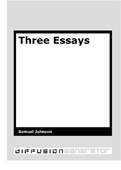
Download A4 | US Letter PDF 390Kb
Selected and Introduced for Short Work by writer and journalist, Bill Thompson
Every journalist should read Samuel Johnson from time to time. First, because the quality of his writing, especially in his essays, is enough to put even the most self-important hack in their place. Second, because he so often discusses why he writes and what writers do with a brutal honesty and lack of self-regard that we should all try to emulate. And third, because he is witty, entertaining and engaging.
The three essays I’ve chosen here cover the range. In Rambler 2 we see Johnson considering the nature of ambition and the many ways we find to deceive ourselves. In Idler 48 he speaks to every Twitter user and blogger of how we ‘play throughout life with the shadows of business’. And in Adventurer 95 he explores the process of writing in an age when, it seemed, there was nothing new under the sun.
They are the perfect refuge from the blogosphere and, since they require no external power, excellent for those long journeys when your laptop battery dies before you reach your destination and the only discarded newspaper to hand is yesterday’s Daily Express.
Bill Thompson
April 2008
Texts sourced from EText Library, University of Virginia and Project Gutenberg.

About : These eBooks were produced by students at the University of Waterloo for the Anarchaeology: Collecting Curating and Communicating Culture course, run jointly by Proboscis and Render in Winter/Spring 2008.
Downloads
- Diane Braga – Cambridge, The City I Didn’t Know A4 | US Letter PDF 1.2Mb
- Colin Carney – KW Bug Out – A4 | US Letter PDF 1.4Mb
- Meghan Doherty – My Town, My Community, My Identity A4 | US Letter PDF 2.2Mb
- Angie Gaal – My UW Campus A4 | US Letter PDF 514Kb
- Christina Gatchene – Alexandra’s Arrangements A4 | US Letter PDF 1.7Mb
- Katie Gatenby – Your Guide to the Sculptures of the University of Waterloo A4 | US Letter PDF 700Kb
- Ruth van Gurp – Guides to Galt: A Brief History of Architectural Spaces A4 | US Letter PDF 1Mb
- Vicky Huang – Something is Missing! A4 | US Letter PDF 3.8Mb
- Amy Lyons – Guides to Galt: Downtown Restaurants A4 | US Letter PDF 1.84Mb
- Rebecca Macdonald & Andrew Guaglio – The Dissatisfied Art Student’s Guide to the Lounges of UW: Volume 1 A4 | US Letter PDF 1.6Mb
- Rebecca Macdonald & Andrew Guaglio – The Dissatisfied Art Student’s Guide to the Lounges of UW: Volume 2 A4 | US Letter PDF 2.6Mb
- Adam Meyer – Prolegomena to Mundanity A4 | US Letter PDF 1.4Mb
- Heidi Overhill – The Wreck of the “Julie Plante” A4 | US Letter PDF 2.8Mb
- Leslie-Anne Purdy – Activism on the UW Campus A4 | US Letter PDF 1.1Mb
- Nathalie Quagliotto – Guide to Proper Etiquette… A4 | US Letter PDF 385Kb
- Kristina Rogers – The Result of a Petition from 1896 A4 | US Letter PDF 4.5Mb
- Jen Stanfel – Campus Space A4 | US Letter PDF 1.8Mb
- Catherine Telford_Keogh – Positive Space Information Booklet A4 | US Letter PDF 300Kb
- Katie Thiel – Katie Thiel: Artist, Waitress, Student, Daughter… A4 | US Letter PDF 835Mb
- Christina Vannelli – Spaces Defined A4 | US Letter PDF 3.8Mb
- Heather Voituk – Local Culinary Talent A4 | US Letter PDF 550Kb
Published March-April 2008
In 2007 I received an Arts Council England Grants for the Arts award that had two aims: to buy time and space to continue on a work-fiction-in-progress, and to explore creative writing in interdisciplinary and research projects.
The work of fiction that I have been developing has a working title of Balkanising Bloomsbury. The project aims to explore a ‘Balkanist’ seam in Anglophone literatures such as fiction and travel writing, as well as other kinds of writing e.g. in the news media – i.e. to explore how ideas about ‘the Balkans’ are created and perpetuated in literature about the region. Within Balkanising Bloomsbury I’ve been creating completely new stories by cutting up, remixing and re-narrativising fragments from a number of historical and contemporary sources. The aim is that my new stories then reflect back critically on the source texts, but also create a new work of fiction.
As part of this project I also wanted to explore the potential for distributing the resulting fragments/ chapters/ short stories in an immediate way, but also aspects of the research process involved. I wanted to share bibliographical references for all of the Balkanising Bloomsbury stories, both in relation to each story/chapter/fragment, but also across the project as a whole. I’m aware that in literary publishing such material is generally hidden, certainly it’s not usually published as part of the finished book – though it may be alluded to in a brief ‘Author’s Note’-type acknowledgement.
The Diffusion Generator seemed to offer a unique means to share not only the stories as I write them, but the thinking, processes and resources being used to create these new works of fiction.
—
In discussion with Proboscis I set a number of aims for the case study:
- Within the framework of the residency my plan was to select a number of stories from Balkanising Bloomsbury and to publish these stories in the Diffusion eBook format, together with research and other data relating to the stories.
- I wanted to explore how the resulting Diffusion eBooks might function across e.g. literary blogs and research networks online, as well as for other kinds of outputs e.g. in readings or creative writing workshops. In other words to explore how the ebooks could be used to create a community around the work in progress in advance of any ultimate print publication of the finished work in book form.
- I wanted to work within the Diffusion eBook format to design templates that could be used to publish further stories beyond the life of the residency. This required working with the Diffusion format to design an infrastructure that could accommodate the kinds of information that would need to be published alongside the stories themselves, and which could then grow as the project develops.
The first step was to learn how to use the Generator itself – working within the various editorial and production processes that the interface requires. Through much of the residency this involved trial and error: pushing one or two stories through the process, getting it wrong, starting again, getting it wrong, starting again etc. Either Karen Martin who was facilitating the residencies, or Giles Lane, were generally on-hand and could point out what I was doing wrong.
Learning how to use the sketchbook and drafting stages within the Generator, e.g. with the version of the Generator I was using, there was a stage during the drafting of each ebook where I needed to replace all punctuation from my original texts, as it wasn’t being recognised in the final stages of the process. The guides available within the Generator interface were very useful in this respect also – as accents and other diacritical marks need to be handled carefully. I also experimented with various word processing programmes to see which produced the most glitch-free transfer in to Diffusion. Bypassing MS Word completely, copying and saving my stories out of Neo-office Open Document formats into plain text via the latest Mac Text Edit software seemed to be the simplest way to do this.
Secondly I designed a bibliography format that would enable me to very simply drop the relevant bibliographical material for each story into the last pages of each eBook. But which could also be used to generate a series bibliography that would be able to be updated and republished every time I publish another story. This required e.g. a ‘titling’ convention to be established. The first iteration of this series-wide bibliography (‘Bibliography v.01’) is at http://diffusion.org.uk/?p=199
I also designed formats and forms of words for the various other bits of metadata that would need to accompany each book: A sentence that would explain the bibliography; the Creative Commons licence to be used and how to represent that in the footnotes; funding acknowledgements; acknowledgements of appearance in other publications; a short, generic Abstract text that could be used across the series and adapted where necessary; an acknowledgement of the Case Study Residency, etc.
The Creative Commons licence that I’ve used for the Diffusion eBooks of Balkanising Bloomsbury is an ‘Attribution – Non-commercial – No Derivatives 2.0 UK licence. See http://creativecommons.org./licenses/by-nc-nd/2.0/uk/
It’s not possible to put links to CC licences within the eBooks themselves, but we can put a link to this on the Diffusion page for each book – alongside the links to e.g. slashdot, digg, stumble that Proboscis have built into the format.
Within the 5-day residency I published six stories from Balkanising Bloomsbury in the Diffusion eBook format, together with a first version of the Bibliography.
—
Following the intensive period of the residency, I now feel that I’d be able to log on to the Generator and using the design templates that I developed for Balkanising Bloomsbury, publish further fragments/stories/chapters of the work in progress, together with all the relevant bibliographical and research data. I will also be able to generate and update new iterations of the designated Bibliography as the project grows. The Bibliography is given version numbers, so that readers/users would be able to easily identify the most recent version, but also dig back in and access snapshots of the project’s growth.
—
I plan to continue using the Diffusion Generator over the coming year or so, as I continue work on the Balkanising Bloomsbury project. Within this continued use, I’d like to explore the possibility of developing a visual/graphic form that could be used in subsequent eBooks from the series, and that would add to the bibliography, abstract etc to further illuminate the creative process behind the stories.
At time of writing I’ve just completed a tour of Australia under the aegis of the 1001 Nights Cast project by Australian artist Barbara Campbell, which was supported by Australia Council, Performance Space, Sydney, and a number of university and cultural partners in Perth, Sydney and Melbourne. I have been giving readings and leading creative writing workshops with various communities – writers groups, students etc. The workshops have been designed around the process I’m using for Balkanising Bloomsbury, and the Diffusion eBooks have been a very useful part of the workshop structure and its delivery. For example: Rather than taking books to these events, I’ve been able to direct my various hosts to the Diffusion site and have print-outs waiting for me at the various locations – we’ve been able to assemble these in the workshops and I’ve been giving readings from the resulting copies of the Balkanising Bloomsbury stories as part of my introductory comments. The books have also been used as a free give-away to workshop participants. I am planning further Balkanising Bloomsbury creative writing workshops within the UK and will continue to use the Diffusion eBook format as a central part of how I deliver them.
—
Some interesting evidence for the community-building potential of the Diffusion eBook format came from blog activity that resulted from my publishing the Balkanising Bloomsbury eBooks on the Diffusion website.
I sent out an e-notification both to my own marketing lists (on 12th November 2007) and via posts on Facebook, which produced numerous responses. I also posted an announcement to the Balkans Academic News group on yahoo, of which I am a member – this e-list goes out to >6,000 users internationally. The announcement was published to the list on 21st November 2007.
Within a day or two of our publishing the Balkanising Bloomsbury fragments, the future-publishing blog http://BookTwo.org – run by James Bridle of http://aptstudio.com and www.shorttermmemoryloss.com – had linked to the site, discussed the Diffusion format at length and used Vimeo to upload a ‘how-to’ video, showing users how to assemble to ebooks from hard copy printouts. This post (from 14th November 2007), and the video, are at http://booktwo.org/notebook/paper-ebooks/
This then was linked to and commented upon by various other blogs including:
Tim Etchells (15th November) at http://www.timetchells.com/notebook/november-2007/file-under-rain/
Fog Soup (15th November) at http://fogsoup.wordpress.com/2007/11/15/textual-remixes/
At time of writing I don’t know how many downloads there have been of the Balkanising Bloomsbury ebooks, but it may be possible to check any peaks in traffic against the dates of these various blog postings?
An unexpected benefit of BookTwo’s support was that Proboscis had planned or discussed the possibility of producing an in-house ‘how-to’ video with residency participants, but were able instead to post James Bridle’s video directly on to the Diffusion site. A final sharing day where all the various case study residents met and discussed each other’s work was very useful. Since completing the residency I have joined the Diffusion Generator User Group on Facebook, and will use that to share further developments with other users as the project grows, but also to maintain contact with new iterations and development phases of the Generator.
I really value the time and work that Proboscis put in to designing and delivering these residencies – it was an incredibly useful and productive process for me, which more than delivered on the residency aims that we established at the outset.
Tony White
April 2008
The eBooks
Bibliography v0.1
The Scene
Hyde Park
Do You Hear That?
Bottle Orchestra
Ahead in the Line
Gobbledegook





Each cube contains a theme with six relating statements. All statements have been said by project participants.
Related eBook: Exploring Greenhill by Gillian Cowell

Download A4 | US Letter PDF 385Kb
About : Food restaurants share similar formats and functions of production for their customers in order to serve people better. These are created for efficient and fast access to ordering food and eating. But what kind of characteristics and relations do these offer for a paying customer?
With fourteen chapters in point form, this step-by-step guide gives you the experience of being the perfect Fast Food customer. The instructions that you will read about comment on proper habit, behavior, and relations that one could present to another person. Proper etiquette is necessary when communicating and relating to others in the public. Any person interested in the socialization of Fast Food culture can use this guide worldwide.
Published March 2008
Nathalie Quagliotto is an Italian Canadian artist. She has received her BFA from Concordia University in 2007 and is currently in the MFA program at the University of Waterloo investigating conceptualism and relational practices. This coming summer she will be apprenticing with the British artist Martin Creed.

guide to proper etiquette at fast food restaurants is licensed under a Creative Commons Attribution-Noncommercial-No Derivative Works 2.5 Australia License
Short Work consists of public domain texts sourced from Project Gutenberg re-published as Diffusion eBooks. As the title suggests, each is a short work of fiction, poetry or prose intended to be enjoyed in those frequent moments of inbetween-ness that punctuate modern life. The initial selection includes works of satire, experimental writing and poetry chosen for their continuing power to affect the way we see the world.
The eBooks
William Blake – Songs of Innocence & Experience
Saki – Beasts and Super Beasts
Gertrude Stein – Tender Buttons
Jonathan Swift – A Modest Proposal
Samuel Johnson – Three Essays (chosen by Bill Thompson)
William Hogarth – The Rake’s Progress
William Hogarth – The Harlot’s Progress
William Hogarth – Industry & Idleness
Thomas Paine – Common Sense (chosen by Alex Steffen)
Update (13/04/2008) : We’ve invited several friends and collaborators to choose their own public domain texts to re-publish as Diffusion eBooks which we’ll be posting every month or so. Today we’ve added the first of these, selected and introduced by technology critic and journalist Bill Thompson, who has chosen Three Essays by Samuel Johnson.
Update (05/05/2008) : Alex Steffen, editor of Worldchanging, has selected and introduced Common Sense by Thomas Paine.

Download
The She-Wolf A4 | US Letter PDF 304Kb
Laura A4 | US Letter PDF 280Kb
The Boar-Pig A4 | US Letter PDF 288Kb
The Brogue A4 | US Letter PDF 276Kb
The Hen A4 | US Letter PDF 288Kb
The Open Window A4 | US Letter PDF 268Kb
The Treasure Ship A4 | US Letter PDF 276Kb
The Cobweb A4 | US Letter PDF 292Kb
The Lull A4 | US Letter PDF 284Kb
The Unkindest Blow A4 | US Letter PDF 280Kb
The Romancers A4 | US Letter PDF 272Kb
The Schartz-Metterklume Method A4 | US Letter PDF 284Kb
The Seventh Pullet A4 | US Letter PDF 304Kb
The Blind Spot A4 | US Letter PDF 272Kb
Dusk A4 | US Letter PDF 272Kb
A Touch of Realism A4 | US Letter PDF 300Kb
Cousin Teresa A4 | US Letter PDF 280Kb
The Yarkand Manner A4 | US Letter PDF 288Kb
The Byzantine Omelette A4 | US Letter PDF 272Kb
The Feast of Nemesis A4 | US Letter PDF 272Kb
The Dreamer A4 | US Letter PDF 272Kb
The Quince Tree A4 | US Letter PDF 272Kb
The Forbidden Buzzards A4 | US Letter PDF 272Kb
The Stake A4 | US Letter PDF 272Kb
Clovis on Parental Responsibilities A4 | US Letter PDF 260Kb
A Holiday Task A4 | US Letter PDF 300Kb
The Stalled Ox A4 | US Letter PDF 284Kb
The Story-Teller A4 | US Letter PDF 292Kb
A Defensive Diamond A4 | US Letter PDF 280Kb
The Elk A4 | US Letter PDF 288Kb
Down Pens A4 | US Letter PDF 272Kb
The Name-Day A4 | US Letter PDF 292Kb
The Lumber Room A4 | US Letter PDF 300Kb
Fur A4 | US Letter PDF 276Kb
The Philanthropist and the Happy Cat A4 | US Letter PDF 276Kb
On Approval A4 | US Letter PDF 300Kb
About : 36 short stories in Saki’s final collection to be published before the First World War and his death. Each story, in one way or another, turns on the presence or role of an animal and its relationship to the humans in the narrative, acutely dissecting their foibles and pretensions.
First Published in 1914 by John Lane, The Bodley Head
Public Domain Text from Project Gutenberg
Saki (Hector Hugh Munro) was born in 1870 and killed by a sniper’s bullet in 1916. His acerbic and macabre short stories lampoon and satirise the mores of upper and middle class Edwardian British society.




